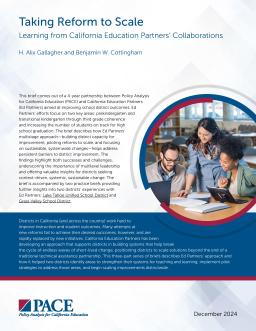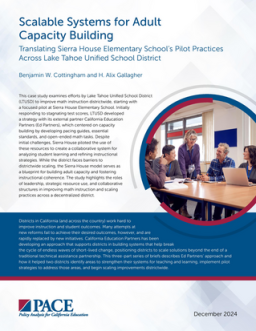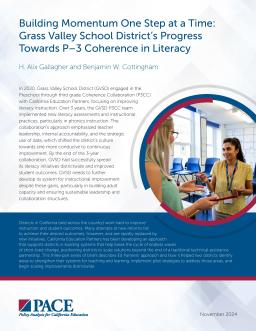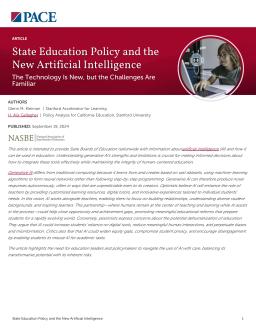Learning from California Education Partners’ Collaborations
December 2024 | Practice brief
This brief introduces a three-part series describing California Education Partners’ multistage approach to supporting school districts with improving their students’ outcomes in literacy and mathematics. The approach addresses persistent barriers to improvement by building capacity in the district, piloting reforms, and focusing on scaling changes systemwide in sustainable ways. PACE authors highlight the successes and challenges of Ed Partners’ approach, emphasizing the fundamental importance of leadership at the teacher, school, and district levels to drive change throughout the district.
Translating Sierra House Elementary School’s Pilot Practices Across Lake Tahoe Unified School District
December 2024 | Practice brief, Case study
This case study explores how Lake Tahoe Unified School District worked to improve math instruction, starting a pilot at Sierra House Elementary School. Partnering with California Education Partners, LTUSD addressed stagnant test scores by developing pacing guides, essential standards, and open-ended math tasks. Sierra House used these tools to create a collaborative system for analyzing student learning and refining instruction. While scaling districtwide remains a challenge, the Sierra House model highlights leadership and resource use with collaboration in advancing instructional coherence.
Grass Valley School District’s Progress Towards P–3 Coherence in Literacy
December 2024 | Practice brief, Case study
Grass Valley School District (GVSD) partnered with California Education Partners through an initiative to improve literacy instruction. Over three years, GVSD implemented new literacy assessments and phonics practices, emphasizing teacher leadership, data use, and accountability. That shifted the district’s culture toward continuous improvement, enabling districtwide adoption of literacy initiatives and improved student outcomes. This case study highlights the need for stronger systems to build adult capacity and sustain leadership and collaboration.
The Technology Is New, but the Challenges Are Familiar
September 2024 | Article
Optimists believe AI will partner with teachers to provide customized learning resources, digital tutors, and innovative experiences tailored to individual students’ needs. Pessimists express concerns about the potential dehumanization of education, arguing that AI could increase students' reliance on digital tools, reduce meaningful human interactions, and perpetuate biases and misinformation. In this article, the authors highlight the need for education leaders and policymakers to navigate the use of AI with care, balancing its transformative potential with its inherent risks.
Pagination
- Page 1
- Next page



